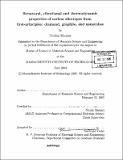Structural, vibrational and thermodynamic properties of carbon allotropes from first-principles : diamond, graphite, and nanotubes
Author(s)
Mounet, Nicolas (Nicolas Frank)
DownloadFull printable version (4.314Mb)
Other Contributors
Massachusetts Institute of Technology. Dept. of Materials Science and Engineering.
Advisor
Nicola Marzari.
Terms of use
Metadata
Show full item recordAbstract
The structural, dynamical, and thermodynamic properties of different carbon allotropes are computed using a combination of ab-initio methods: density-functional theory for total-energy calculations and density-functional perturbation theory for lattice dynamics. For diamond, graphite, graphene, and armchair or zigzag single-walled nanotubes we first calculate the ground-state properties: lattice parameters, elastic constants and phonon dispersions and density of states. Very good agreement with available experimental data is found for all these, with the exception of the c/a ratio in graphite and the associated elastic constants and phonon dispersions. Agreement with experiments is recovered once the experimental c/a is chosen for the calculations. Results for carbon nanotubes confirm and expand available, but scarce, experimental data. The vibrational free energy and the thermal expansion, the temperature dependence of the elastic moduli and the specific heat are calculated using the quasi-harmonic approximation. Graphite shows a distinctive in-plane negative thermal-expansion coefficient that reaches its lowest value around room temperature, in very good agreement with experiments. The predicted value for the thermal-contraction coefficient of narrow single-walled nanotubes is half that of graphite, while for graphene it is found to be three times as large. (cont.) In the case of graphene and graphite, the ZA bending acoustic modes are shown to be responsible for the contraction, in a direct manifestation of the membrane effect predicted by I. M. Lifshitz over fifty years ago. Stacking directly hinders the ZA modes, explaining the large numerical difference between the thermal-contraction coefficients in graphite and graphene, notwithstanding their common physical origin. For the narrow nanotubes studied, both the TA bending and the "pinch" modes play a dominant role. For larger single-walled nanotubes, it is postulated that the radial breathing mode will have the! most significant effect on the thermal contraction, ultimately reaching the graphene limit as the diameter is increased.
Description
Thesis (S.M.)--Massachusetts Institute of Technology, Dept. of Materials Science and Engineering, 2005. Includes bibliographical references (p. 95-104).
Date issued
2005Department
Massachusetts Institute of Technology. Department of Materials Science and EngineeringPublisher
Massachusetts Institute of Technology
Keywords
Materials Science and Engineering.